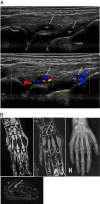Comparison of ultrasonography with Doppler and MRI for assessment of disease activity in juvenile idiopathic arthritis: a pilot study
- PMID: 22897976
- PMCID: PMC3608365
- DOI: 10.1186/1546-0096-10-23
Comparison of ultrasonography with Doppler and MRI for assessment of disease activity in juvenile idiopathic arthritis: a pilot study
Abstract
Background: In juvenile idiopathic arthritis (JIA), the trend towards early therapeutic intervention and the development of new highly effective treatments have increased the need for sensitive and specific imaging. Numerous studies have demonstrated the important role of MRI and US in adult rheumatology. However, investigations of imaging in JIA are rare, and no previous study has been comparing MRI with Doppler ultrasonography (US) for assessment of arthritis. The aim of the present study was to compare the two imaging methods regarding their usefulness for evaluating disease activity in JIA, and to compare the results with those obtained in healthy controls.
Methods: In 10 JIA patients (median age 14 years, range 11-18), 11 joints (six wrists, three knees, two ankles) with arthritis were assessed by color Doppler US and MRI. The same imaging modalities were used to evaluate eight joints (three wrists, three knees, two ankles) in six healthy age- and sex-matched controls. The US examinations of both the patients and controls were compared with the MRI findings.
Results: In 10 JIA patients, US detected synovial hypertrophy in 22 areas of 11 joints, 86% of which had synovial hyperemia, and MRI revealed synovitis in 36 areas of the same 11 joints. Erosions were identified by US in two areas of two joints and by MRI in six areas of four joints. Effusion was shown by US in nine areas of six joints and by MRI in 17 areas of five joints. MRI detected juxta-articular bone marrow edema in 16 areas of eight joints.
Conclusions: The results of this pilot study indicate that both MRI and US provide valuable imaging information on disease activity in JIA. Importantly, the two techniques seem to complement each other and give partly different information. Although MRI is considered to be the reference standard for advanced imaging in adult rheumatology, US seems to provide useful imaging information that could make it an option in daily clinical practice, in JIA as well as in adult rheumatology. However, the current work represents a pilot study, and thus our results need to be confirmed in a larger prospective clinical investigation.
Figures





Similar articles
-
Ultrasound and MRI of the foot in children and adolescents newly diagnosed with juvenile idiopathic arthritis.J Ultrason. 2023 Sep 11;23(94):e106-e113. doi: 10.15557/jou.2023.0019. eCollection 2023 Sep. J Ultrason. 2023. PMID: 37701052 Free PMC article.
-
Magnetic resonance imaging findings in the sternoclavicular joint in juvenile idiopathic arthritis and comparison with clinical examination.Clin Rheumatol. 2021 Jun;40(6):2351-2359. doi: 10.1007/s10067-020-05525-2. Epub 2021 Jan 2. Clin Rheumatol. 2021. PMID: 33387092
-
Imaging in juvenile idiopathic arthritis with a focus on ultrasonography.Clin Exp Rheumatol. 2013 Jan-Feb;31(1):135-48. Epub 2012 Dec 13. Clin Exp Rheumatol. 2013. PMID: 23294536 Review.
-
Ultrasonography and color Doppler in juvenile idiopathic arthritis: diagnosis and follow-up of ultrasound-guided steroid injection in the ankle region. A descriptive interventional study.Pediatr Rheumatol Online J. 2011 Jan 29;9(1):4. doi: 10.1186/1546-0096-9-4. Pediatr Rheumatol Online J. 2011. PMID: 21276257 Free PMC article.
-
Advances and challenges in imaging in juvenile idiopathic arthritis.Nat Rev Rheumatol. 2012 Mar 27;8(6):329-36. doi: 10.1038/nrrheum.2012.30. Nat Rev Rheumatol. 2012. PMID: 22450553 Review.
Cited by
-
The influence of long distance running on sonographic joint and tendon pathology: results from a prospective study with marathon runners.BMC Musculoskelet Disord. 2016 Jul 11;17:272. doi: 10.1186/s12891-016-1121-9. BMC Musculoskelet Disord. 2016. PMID: 27400865 Free PMC article.
-
Imaging assessment of children presenting with suspected or known juvenile idiopathic arthritis: ESSR-ESPR points to consider.Eur Radiol. 2020 Oct;30(10):5237-5249. doi: 10.1007/s00330-020-06807-8. Epub 2020 May 12. Eur Radiol. 2020. PMID: 32399709 Free PMC article. Review.
-
Synovial explant inflammatory mediator production corresponds to rheumatoid arthritis imaging hallmarks: a cross-sectional study.Arthritis Res Ther. 2014 May 5;16(3):R107. doi: 10.1186/ar4557. Arthritis Res Ther. 2014. PMID: 24886513 Free PMC article.
-
Association between IL-6 production in synovial explants from rheumatoid arthritis patients and clinical and imaging response to biologic treatment: A pilot study.PLoS One. 2018 May 22;13(5):e0197001. doi: 10.1371/journal.pone.0197001. eCollection 2018. PLoS One. 2018. PMID: 29787569 Free PMC article.
-
Musculoskeletal ultrasound in children: Current state and future directions.Eur J Rheumatol. 2020 Feb;7(Suppl1):S28-S37. doi: 10.5152/eurjrheum.2019.19170. Eur J Rheumatol. 2020. PMID: 35929859 Free PMC article.
References
-
- Filippou G, Cantarini L, Bertoldi I, Picerno V, Frediani B, Galeazzi M. Ultrasonography vs. clinical examination in children with suspected arthritis. Does it make sense to use poliarticular ultrasonographic screening? Clin Exp Rheumatol. 2011;29:345–350. - PubMed
-
- Guzman J, Burgos-Vargas R, Duarte-Salazar C, Gomez-Mora P. Reliability of the articular examination in children with juvenile rheumatoid arthritis: interobserver agreement and sources of disagreement. J Rheumatol. 1995;22:2331–2336. - PubMed
LinkOut - more resources
Full Text Sources

